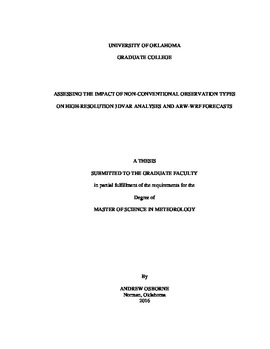| dc.contributor.advisor | Carr, Frederick | |
| dc.contributor.author | Osborne, Andrew | |
| dc.date.accessioned | 2016-12-20T15:03:52Z | |
| dc.date.available | 2016-12-20T15:03:52Z | |
| dc.date.issued | 2016-12 | |
| dc.identifier.uri | https://hdl.handle.net/11244/47100 | |
| dc.description.abstract | This work looks at the impact on high-resolution analyses and forecasts of several non-conventional data types available within the Dallas Fort Worth (DFW) Urban Testbed. A major focus is an evaluation of the added value of the Center for Collaborative Adaptive Sensing of the Atmosphere (CASA) X-band radar network in the DFW area. The impact of this radar data is compared to that of the other radar networks in the area including the Next-Generation (WSR-88D NEXRAD) radars and the Terminal Doppler Weather Radars (TDWRs). Data denial experiments are performed using the Advanced Regional Prediction System (ARPS) Three-Dimensional Variational (3DVAR) analysis system and the Advanced Research Version of the Weather Research and Forecasting Model (ARW-WRF). Cycled data assimilation is performed on a 1 km grid with subsequent forecast performed on a 400 m grid. The case chosen is the 26 December 2015 tornado outbreak in north-central Texas with specific focus on model simulations of the Rowlett tornadic supercell. Verification results and comparison among data denial experiments show that the WSR-88D radar network appears to supply the most important data for this case. Forecasts of reflectivity (verified via fractions skill score (FSS)) and low-level rotation (0-1 km updraft helicity tracks verified via object-based track error algorithm) were able to accurately capture the storm evolution but only when the WSR-88D radar data was included. The Rowlett storm is on the edge of the shorter-range CASA and TDWR networks and so these radars are not able to provide sufficient observations to initialize the storm properly in the model. A noticeable increase in rotational intensity in the forecasted storm, possibly to unrealistic values, is found when CASA radar data is denied from the control experiment. Comparison of model quantitative precipitation forecast (QPF) output with observed rainfall estimates indicate a wet bias in the model used here which makes the precipitation forecasts less useful than the rotational forecasts. A separate experiment focus on surface observation impact found substantial positive impact of non-conventional surface observations on frontal placement southwest of the DFW metropolitan area. | en_US |
| dc.language | en_US | en_US |
| dc.subject | Data assimilation/Data impact | en_US |
| dc.title | Assessing the impact of non-conventional observation types on high-resolution 3DVAR analyses and ARW-WRF forecasts | en_US |
| dc.contributor.committeeMember | Brewster, Keith | |
| dc.contributor.committeeMember | Wang, Xuguang | |
| dc.date.manuscript | 2016-12-14 | |
| dc.thesis.degree | Master of Science in Meteorology | en_US |
| ou.group | College of Atmospheric & Geographic Sciences::School of Meteorology | en_US |
